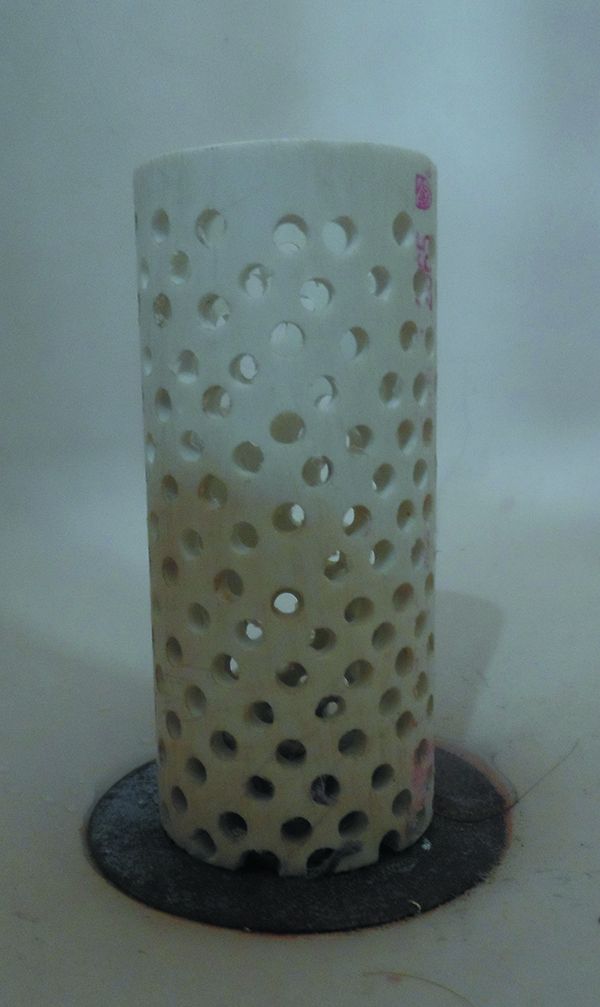Wire mesh screens are a pain to clean. Fibers push through neighboring holes, resulting in what is known in the industry as “stapling.” They jam in the corners and between the wires of the weave. Wiping, scraping, and even wire brushing only pushes the fibers farther into crevices, securing them ever more tightly. In the case of a basket strainer the problem is compounded by the debris being on the inside of the basket.
The ultimate abomination is expanded metal, with diamond shaped holes. The fibers catch in the corners and won’t come out no matter what. A special level in hell is reserved for people who make strainers from expanded metal.
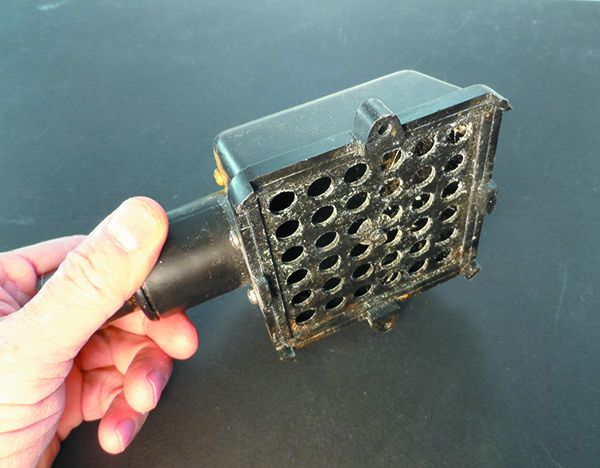
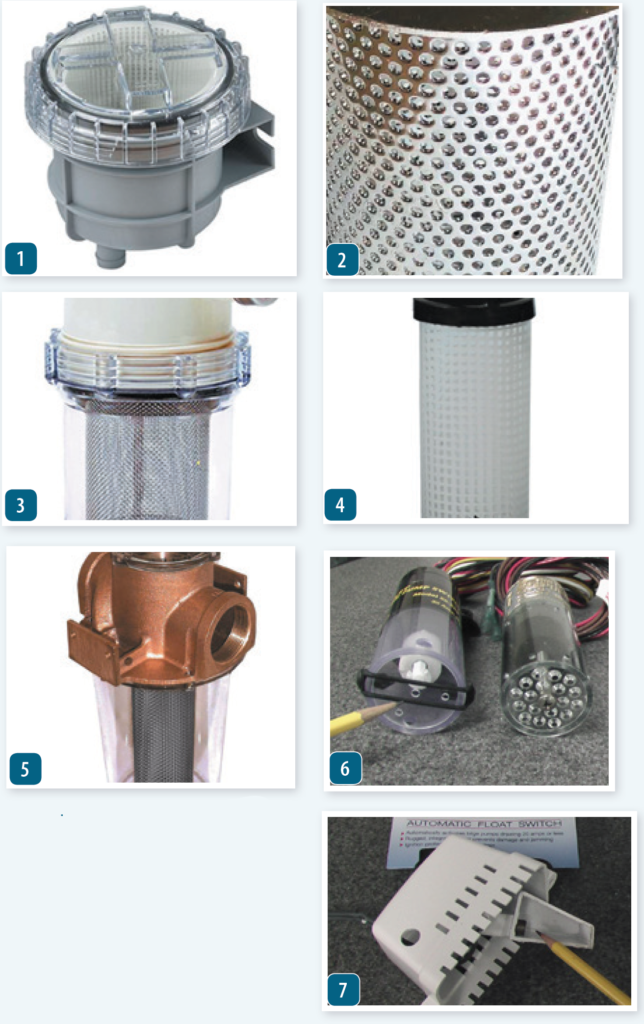
Materials matter. So does design. Plastic strainers are inexpensive, but they, or their bowls, are vulnerable to chemicals in some anti-freeze concoctions (see PS December 2017 ”Winterizing Wisdom from the Chemistry Lab”).
Some designs are clearly easier to inspect and clean. Given the propensity for weeds and algae to get sucked into our boat’s cooling system, ease of maintenance is high on our list of desirable features.
- Testers found the square openings on the Vetus filter are more difficult to clean than other kinds of perforations.
- This close up shows a perforated strainer basket typical of popular intake filters.
- This inexpensive Sureflow filter has a wire basket. It’s nylon bowl is vulnerable to some antifreeze.
- Groco’s poly propylene filter features square holes like the Vetus.
- The Perko silicon bronze housing with glass bowl and perforated metal strainer has been around for decades.
- The water-activated activated bilge switches we tested in September 2005 had small strainers to protect against debris.
- Two levels of grating protect the automatic float-switches from clogging. Although these are not commonly vulnerable to clogging, a plastic bag or large debris could interfere with it. A DIY strum box would add another layer of protection.

At the Dock
The cure is to use perforated metal with round holes. With no corners to trap fibers, the debris can be brushed off with little trouble. When they must be scraped, the fibers will shear cleanly. If there is gravity forcing the flow towards the screen, and the screen area is large enough, often gravity alone is enough to drop the debris off the screen, making cleaning a breeze.
Common sense suggests that wire screen has a greater percentage of open area than perforated sheet metal, but the difference is quite small if the wire is strong enough to resist pump pressure and vigorous cleaning. In the size range of common interest (1/8-inch to 3/16-inch) perforated metal has about 40-63 percent open area, compared to 55-63 percent for wire mesh. It is much easier to clean perforated metal, and since the strainer will start its work cycle cleaner, the difference is negligible.
For example: Perko makes high-quality raw water strainers. They use 22 gauge 316 stainless steel with 0.077-inch holes (just larger than 1/16-inch), providing 46 percent open area. Below 1/16-inch perforated metal becomes difficult to manufacture and is replaced by fine screen supported by a coarse perforated basket, making it even harder to clean.
The bottom of the strainer basket can be solid; normally solids settle there, rendering it blind anyway.
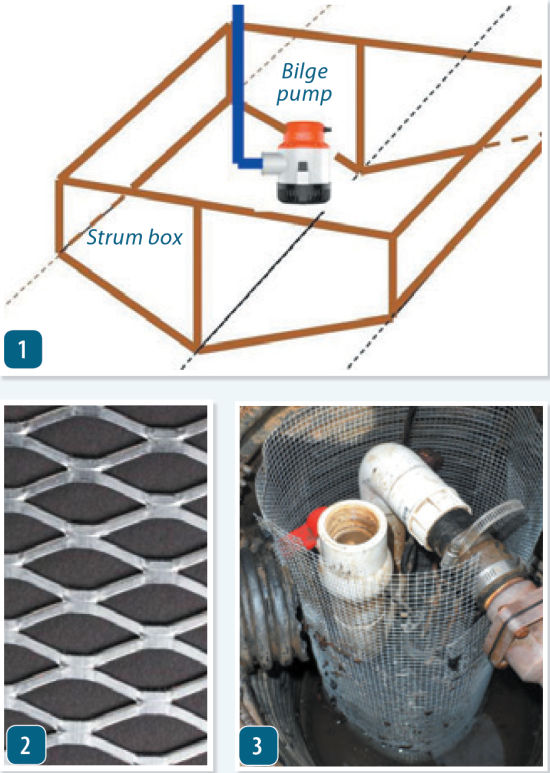
The nemesis of inline strainers and pump inlet screens is limited area. High flow and the resulting pressure drop forces the debris deep into the holes, causing stapling and making cleaning difficult. Limited area reduces flow and increases cleaning frequency.
What if a strainer is built around the sump pump, allowing much greater area, so large that the pressure drop is reduced to no more than gravity? Instead of driving the trash into the mesh, debris often just falls off between cycles. If not, it is easily brushed off, because it is not driven into the holes.
The ultimate in sump pump protection. The box frame can be wood, metal angle, or fiberglass. The sides are ¼-inch perforated metal. The top can be left open. About 8 inches deep and 1-2 feet on a side.
Minimum size is about 5 square inches per gallons per minute (GPM) flow, or about 150 times the pipe flow area, although twice this is better. This is more than 5-10 times the minimum recommend pipe strainer area.
Sure, keeping the bilge clean is the best practice, but even well maintained boats accumulate some hair and splinters, and in the event of serious flooding or a knock-down, all matter of paper scraps can wash down from nooks and crannies you didn’t know you had.
- A variation on the strum box, this DIY strainer is simple to build, clog-proof (it will overflow down the drain when it clogs) and can provide a lot of surface area.
- Do NOT use expanded metal as shown here. Use perforated metal for the sides.
- This hardware cloth strum box keeps sticks out of tech editor Drew Frye’s backyard sump pump.

You can buy perforated stainless and make your own, though the fabrication of baskets can be tricky. But hold that thought, because your sump pump may well benefit from a strum box (see “Strum Box” sidebar), and those are easier to fabricate from perforated metal than screen because of the greater stiffness. Expect to pay about $60 for 24-in. x 24-in. x 20 gauge in 304 stainless punched in common hole sizes. It will hold up well enough even in seawater, because there are no anoxic zones. 316 stainless is harder to find in small quantities, but McMaster-Carr sells sheets of perforated metal.
Plastic strainers can be drilled from PVC pipe or plastic tubing (see “Ultimate Tub and Cockpit Strainer” sidebar). Drilling that many holes in stainless tubing is just impractical.
Wire screens are acceptable in applications where you really don’t expect debris. Protecting a potable water pressure pump is one application, since the water should have been pre-filtered and the tank should be clean.
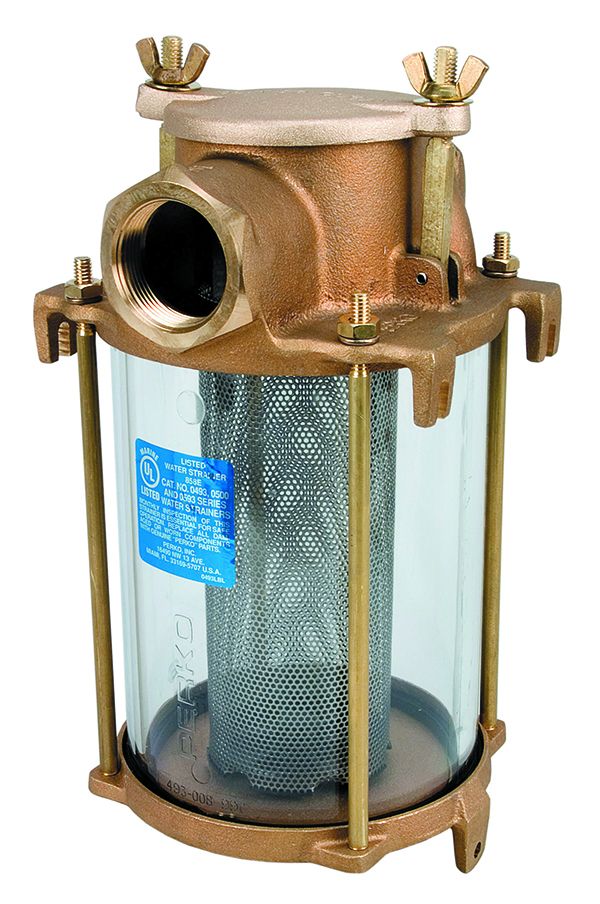
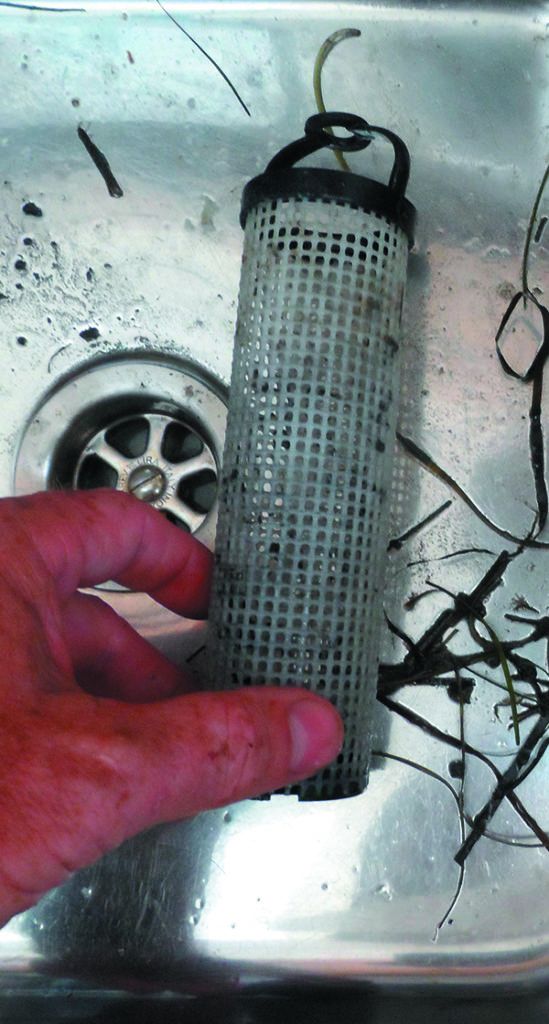
This sounds dead simple, but having cleaned thousands of strainers, I’ve learn a few shortcuts. The following assumes we are cleaning a basket strainer with the debris on the inside. If the debris is on the outside reverse the process.
- Scrape the outside with the back of a knife to shear stapled fibers. Alternatively, scrubbing with a wire brush may be easier, although the shearing action is not as strong.
- Wipe the inside of the basket with a small brush in a smooth rotary manner, not back and forth. You want to pull the fibers out, not scrub them in.
- Rinse from the outside with a strong stream. This should help push fibers through to the inside.
- Repeat as needed.
Additional notes
A few small details can make a big difference when selecting the right strainer for the job
- Install valves near both sides of any inline strainer. If you can’t easily clean it, you won’t.
- Threaded covers are notoriously prone to jamming when over tightened. Clean the threads carefully , use silicone grease, and tighten only the bare minimum. Replace O-rings sooner than needed to avoid the need to over tighten. Get the right wrench, and only use it for removal (hand tighten only). Remove at least twice each year.
- Plan ahead. How will you clean up the inevitable mess? There should be space for a pan.

Other Strainer Tips
Avoid duplex strainers or filters with an integrated valve.
I’m not a fan after too many crippling failures, no matter how neat they look. Multiple valves are not as pretty, but they are more reliable and more versatile (you have to option of running on both strainers or closing off both). You do need to pay attention to which valves are open, but this is simple.
- Provide space to pull the basket easily. Provide a means to drain the bowl in case there is trash down there.
- Fuel strainers should never be located over anything hot. Water strainers should never be over electrical or other sensitive equipment.
- The area of the strainer should be at least five times the pipe area if no debris is actually expected (potable water systems, other installations for pump protection only), and 20 times or more if debris is expected (raw water and sump pumps). The larger the strainer, the less frequently cleaning is required.
- Hose-end strum box strainers and bilge pumps in deep bilges should be fitted with a lanyard to lift them for regular cleaning.
- Always direct the water flow upwards through a strainer. The strainer will be easier to prime after cleaning and will not fill with air, reducing capacity.

Conclusions
Wire mesh and expanded metal screens are cost-cutting measures. Perforated metal or plastic with round holes is always better. It’s stronger, lasts longer, and most importantly, is much easier to clean.
There are companies that make custom strainers for big money, or you can make your own from PVC pipe. Vary the hole size according to the application, remembering there is seldom good reason to go smaller than 3/32-inch (9/64-inch is the industry standard for most plumbing).
Technical Editor Drew Frye is the author of Rigging Modern Anchors. He blogs at www.sail-delmarva.blogspot.com
This article was originally published on 23 March 2021 and has been updated.



































